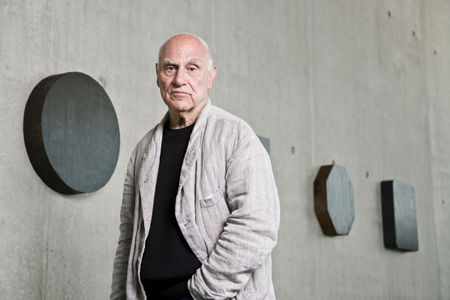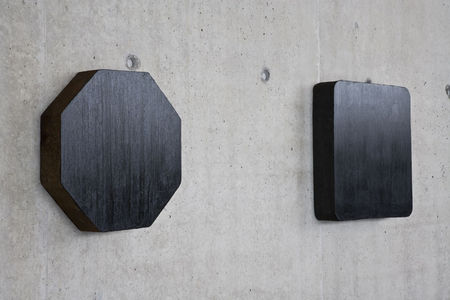Richard Serra Drawings/Work @ Kunsthaus Bregenz in Austria
Richard Serra, Portrait. Photo: Markus Tretter. © Richard Serra/VBK, Wien, 2008, Kunsthaus Bregenz.
BREGENZ.- In an unparalleled exhibition, the Kunsthaus Bregenz will be showing more than 60, mostly large-format drawings by one of the major sculptors and draftsmen of our day. Following exhibitions in Maastricht 1990 (Bonnefantenmuseum) and in London 1992 (Serpentine Gallery), this will be the first comprehensive presentation of Richard Serra’s graphic oeuvre ever shown in Europe.
Selected in conjunction with the artist, the works on display bring together key work series from important private collections and museums in Europe and the USA, as well as new pieces produced by Richard Serra especially for the exhibition in Bregenz. All in all, the exhibition will include six work series, setting the stage for a dialogue spanning nearly twenty years of artistic production. The exhibition is arranged on four levels and comprises the large-format “Diptychs,” 1989, the series “Weight and Measure,” 1994, “Rounds,” 1996/97, and “out-of-rounds,” 1999, and the artist’s most recent works “Solids,” 2007/08, and “Forged Drawing,” 2008.
Richard Serra was born in San Francisco in 1939. After studying painting with Josef Albers at the Yale University School of Art and Architecture, where he graduated in 1964/65, Serra continued his training abroad, spending a year each in Florence and Paris. Since then, Richard Serra has lived in New York, where he first used rubber in 1966 and began applying his characteristic work material lead in 1968. Here, also, the principles of supporting and leaning were put to the test, which were later expanded to become the fundamental principle of his sculptural work. During this time he developed his own sculptural grammar, which was based on formal reductionism, an active site-specific reference, and the central theme of gravity and balance. This results in sculptures that let the viewer experience the critical balance of different forces and whose large-scale dimensions impart a strong physical and emotional experience.
Serra’s first solo exhibition in 1969 at the Leo Castelli Gallery in New York was followed by many large international presentations of his sculptural work, landscape projects, and site-specific installations using his primary material: steel. After his large-scale retrospective at the Museum of Modern Art in 2007, Richard Serra is currently showing “Promenade,” the monumental sculpture he created for the Grand Palais in Paris.
Since 1971, Serra has focused not only on sculptural works, but also on large-scale drawings using various techniques. These are as important to him as his sculptures, and as the artist himself explains: “I like to draw. It is an activity I rely on, a dependency of sorts. Drawing gives me an immediate return for my effort and the result is commensurate with my involvement. It is an activity that requires solitude, it is the most concentrated space in which I work.”
In another context, he calls drawing the source of his artistic activity, not least because it affords him the freedom to think about the elementary conditions of his sculptural pieces without needing to rework them. Serra has always drawn. He was accepted to the Yale School of Art based on the drawings he submitted. The color he uses in his drawings is black. A dense layer of paintstick absorbs and dissipates light; what emerges is the mass, density, and volume of the drawing. “Black is a property, not a quality. In terms of weight, black is heavier, creates a larger volume, holds itself in a more compressed field. It is comparable to forging. […] To use black is the clearest way of marking against a white field.” (Richard Serra) In other words, the artist finds it is also the clearest way of indicating something without triggering associations because black is interpreted as a material substance rather than a color. Unlike the site-specific “Wall Drawings,” which, rendered directly onto cloth, operate with the proportions and scales of the existing architecture, Serra’s drawings on paper are not bound by context. The frame serves, instead, to separate the paper drawing from the wall.
Richard Serra’s drawing material is the paintstick, a wax-like grease crayon. Serra melts several paintsticks to form large pigment blocks. This transformation allows him to apply the black material in broad, dense strokes. Warming or melting the material for his drawings, he applies it either directly onto the paper with large sweeps of his arm, or he uses a window-screen as an intermediary surface through which he presses the color. In his recent “Solids,” Richard Serra goes a step further. “Melted paintstick is poured onto a hard surface on the floor.
Sometimes, not always, a sheet of window-screen is placed on top of the liquid paintstick. Then the paper is laid down, either on top of the screen or directly on top of the liquid paintstick. Pressure is exerted on the back of the paper with a hard marking tool. The front side of the paper picks up the mark. With a few exceptions where the front is marked through a blackened screen, no direct drawing is done on the front of the paper. I don’t see the drawing I am making until the paper is pulled off the floor and turned over or the screen is lifted.”
The material and the entire work process serve to build the drawing step by step. It is an elementary process, which, carried out with intense energy, is the result of direct action. By splitting and discontinuing the flow, Richard Serra avoids the gestural and allows a dense superficial construction. Serra avoids gestural features in order to sharpen the awareness of the viewer and draw attention to one’s own corporeality. He is not concerned with subjective gestures or narrative references; at the core of his drawings is the principle of marking, of the anonymous characteristic style in which the drawing seems to find its form through the density of the material and the compact work process. Precisely because every illusory strategy is avoided, the forms are at the same time able to imply weight, mass, and volume. For, particularly through his training with Josef Albers, Richard Serra is fully aware that the weight of a drawing does not just depend on the layers of paintstick applied, but above all on its form.
For the works of the series “Weight and Measure,” Richard Serra has brought together two large sheets of double-laminated Hiromi paper. He treats each of the two as an active substance rather than a passive ground by positioning the upper sheet so that it only very slightly overlaps with the lower one. Together with the black areas applied as layers of paintstick, these drawings, like the “Diptychs,” are reminiscent in their work process of the balancing of steel slabs with space, weight, equilibrium, size, scale, placing, and density.
The series “Rounds” and “out-of-rounds” result from the application of material in an exhausting process, which, by virtue of the thick layers of paintstick, gives the forms material presence, mass, and weight. In this way, in “out-of-rounds” a curved cardboard shape marks the circumference and defines the paintstick borders during application. Liquid material under pressure shoots out and produces the explosive markings at the edges.
With his “Forged Drawing,” which was created especially for Bregenz, Serra picks up on a work series from the seventies and eighties. It deals with steel masses in each of the four basic shapes that can be forged with a blacksmith’s hammer: circle, rectangle, octagon, and square. “These are the building blocks which most forged products can be traced back to. I thought it would be worth the effort to point out that the circle, rectangle, octagon, and square are the graphic elements from which everything a blacksmith forges derives. I interpreted this literally and re-presented this idea by hanging the steel forms on the wall and covering their surfaces with a paintstick.”
Serra’s programmatic drawing concept of connecting body awareness with material and integrating both visual and tactile perception allows the viewer to experience a densified, intensified space in connection with densified, materialized time. Eckhard Schneider
Richard Serra, Installation view Kunsthaus Bregenz, ground floor. Photo: Markus Tretter © Richard Serra/VBK, Wien, 2008, Kunsthaus Bregenz

/https%3A%2F%2Fprofilepics.canalblog.com%2Fprofilepics%2F1%2F0%2F100183.jpg)
/https%3A%2F%2Fstorage.canalblog.com%2F03%2F02%2F119589%2F96711876_o.jpg)
/https%3A%2F%2Fstorage.canalblog.com%2F11%2F31%2F119589%2F94773502_o.jpg)
/https%3A%2F%2Fstorage.canalblog.com%2F20%2F83%2F119589%2F94772815_o.jpg)
/https%3A%2F%2Fstorage.canalblog.com%2F26%2F72%2F119589%2F75604929_o.jpg)
/https%3A%2F%2Fstorage.canalblog.com%2F59%2F60%2F119589%2F26458628_o.jpg)




/http%3A%2F%2Fstorage.canalblog.com%2F40%2F89%2F119589%2F128370741_o.jpg)
/http%3A%2F%2Fstorage.canalblog.com%2F51%2F93%2F119589%2F126042559_o.jpg)
/http%3A%2F%2Fstorage.canalblog.com%2F28%2F31%2F119589%2F122346101_o.jpg)
/http%3A%2F%2Fstorage.canalblog.com%2F58%2F65%2F119589%2F111497376_o.jpg)